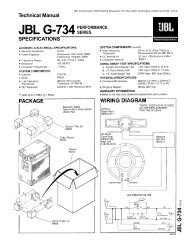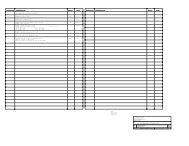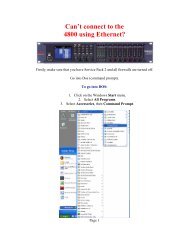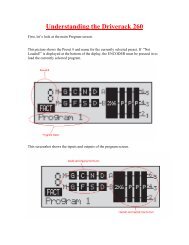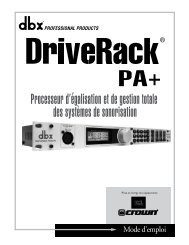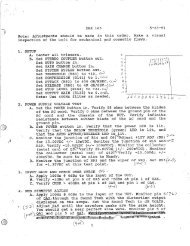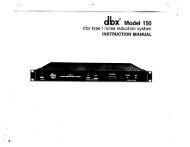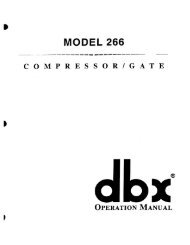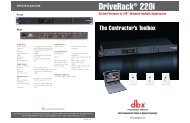Create successful ePaper yourself
Turn your PDF publications into a flip-book with our unique Google optimized e-Paper software.
Figure 2<br />
Line level<br />
setup for<br />
<strong>PS110</strong> suing<br />
internal high<br />
pass filter.<br />
Out<br />
Left<br />
Out<br />
Right<br />
Out<br />
A/V RECEIVER<br />
OR<br />
SURROUND PROCESSOR<br />
Signal Source<br />
Figure 3<br />
Line level setup for<br />
<strong>PS110</strong>B using internal<br />
high pass filter.<br />
Out<br />
Left Right<br />
+<br />
Speaker Level IN<br />
Speaker Level OUT<br />
+<br />
AMPLIFIER<br />
Right Speaker<br />
Left Speaker<br />
b: (Optional) You may choose to allow the main speaker systems<br />
to operate full bandwidth, in which case you will not require the<br />
cables from the subwoofer outputs to the main speaker amplifier<br />
inputs. This approach does not high pass your main speakers<br />
and may or may not offer the best perfor<strong>man</strong>ce characteristics.<br />
Some experimentation will be required to achieve optimum<br />
results. (<strong>PS110</strong> fig. 4, <strong>PS110</strong>B fig 5).<br />
Figure 4<br />
Setup for discrete subwoofer<br />
channel for <strong>PS110</strong><br />
figure 5<br />
Setup for<br />
discrete<br />
subwoofer<br />
channel for<br />
<strong>PS110</strong>B<br />
Out<br />
Signal Source<br />
Out Out<br />
In In<br />
Main Speaker<br />
Amplifier<br />
Out Out<br />
Ensure that your left and right channels have been connected<br />
correctly through the chosen signal chain. Turn the gain control<br />
to minimum. Turn the subwoofer amplifier "On" and verify the<br />
LED is illuminated, indicating power is present. Note that the unit<br />
features an auto on/off circuit, which will turn the subwoofer off if<br />
there is no input signal for more than two minutes (indicated by<br />
the green LED turning to red). The sub will instantaneously turn<br />
on again, (indicated by the red LED turning green) as soon as an<br />
input signal is received. Start your program material and adjust<br />
your main speakers to the normal listening level. If you have high<br />
passed the main speakers, do not be alarmed that they sound<br />
thinner, all the energy below 80 Hz out of them for use by the subwoofer.<br />
In<br />
-<br />
-<br />
Right<br />
In<br />
<strong>PS110</strong><br />
L<br />
Input<br />
High Pass<br />
Output<br />
<strong>PS110</strong><br />
Out<br />
Left<br />
Right<br />
R<br />
Sub Out<br />
Left<br />
In<br />
A/V RECEIVER<br />
OR<br />
SURROUNG PROCESSOR<br />
<strong>PS110</strong><br />
L<br />
Input<br />
High Pass<br />
Output<br />
<strong>PS110</strong><br />
Right<br />
Out<br />
Left<br />
Out<br />
AMPLIFIER<br />
IN<br />
OUT<br />
IN<br />
OUT<br />
Main<br />
Speakers<br />
IN OUT<br />
Left<br />
Right<br />
Left Right<br />
+<br />
Speaker Level IN<br />
-<br />
-<br />
Speaker Level OUT<br />
+<br />
R<br />
Main<br />
Speakers<br />
Now, adjust the subwoofer gain control until you’re satisfied with<br />
a suitable level to match the main speakers. If something isn’t<br />
working at this stage, you can go ahead to the troubleshooting<br />
section, get things running, and then come back to find out how<br />
to make it work even better.<br />
5.0 Adjustable controls<br />
a: Sub Level (Gain Control)<br />
Adjusts the level of the subwoofer without affecting the signal<br />
level that goes to your main speaker amplifier. Because the subwoofer<br />
has an integral crossover filter, this will also act as a bass<br />
shelving control for your complete loudspeaker system. While it is<br />
tempting to turn the subwoofer levels up, it is there to reproduce<br />
low frequencies with less effort, and lower distortion, than the<br />
main speakers alone can achieve. The most important thing is to<br />
maintain a balanced audio spectrum.<br />
b: Crossover Frequency (Variable Low Pass Filter)<br />
This adjusts the crossover point for the subwoofer. In this system,<br />
that high pass filter point is fixed at 12 dB / Octave at 80 Hz.<br />
The variable low pass filter has a range of 40 Hz to 150 Hz at a<br />
24 dB / Octave slope, which allows you to adjust the amount of<br />
overlap in the operating range of the subwoofer by about half an<br />
octave. As you adjust the level of the subwoofer relative to the<br />
main speakers, you will find that you need to adjust the low pass<br />
filter point to avoid having a bump or hole in the bass response<br />
at the 80 Hz crossover point. While you could think of this as a<br />
bass control of sorts, it’s really there to help match the perfor<strong>man</strong>ce<br />
of your main speakers.<br />
c: Crossover Mode<br />
Overrides the subwoofer internal low pass filter in the "all pass"<br />
position. The "all pass" switch position can be used when experimenting<br />
with a discrete subwoofer channel arrangement. Careful<br />
and thoughtful use of the controls are required to achieve the<br />
best results.<br />
For certain music and film production applications, it is <strong>man</strong>datory<br />
to run the L.F.E. (Low Frequency Effects) information through<br />
an outboard proprietary production DSP unit. In this situation, it<br />
is a requirement that the subwoofer being used has a linear frequency<br />
response up to 300 Hz. This can be achieved by switching<br />
the crossover mode switch to the "all pass" position, which<br />
overrides the subwoofers internal low pass filter. When no outboard<br />
DSP processor is <strong>man</strong>dated, the internal low pass filter<br />
must be engaged, (switch in the low pass mode) to operate the<br />
internal low pass crossover frequency feature.<br />
d: LF Boost<br />
This control offers the user the ability to boost the extreme low<br />
frequency energy below 63 Hz, up to a maximum level of 4 dB in<br />
a linear shelf mode. The maximum boost is obtained by turning<br />
the adjustment knob fully clockwise. The boost is eliminated once<br />
the knob is returned to the full counter-clockwise position. This<br />
feature is to enhance extreme low frequencies for maximum<br />
effects. As with all equalization, we advise its use in moderation.<br />
e: Phase Switch<br />
Depending on the distance that your subwoofer is placed from your<br />
main speakers, it may be necessary to reverse the phase of the<br />
subwoofer. This is achieved by simply moving the switch to the<br />
180 degree position. In most cases, you will find that the main<br />
speakers will work best in the 0 degree position. In any case, trying<br />
both positions of the switch will allow for quick reference. The switch<br />
is in the correct position for your setup when the low frequency<br />
output is greatest at, and below, the crossover point selected.




